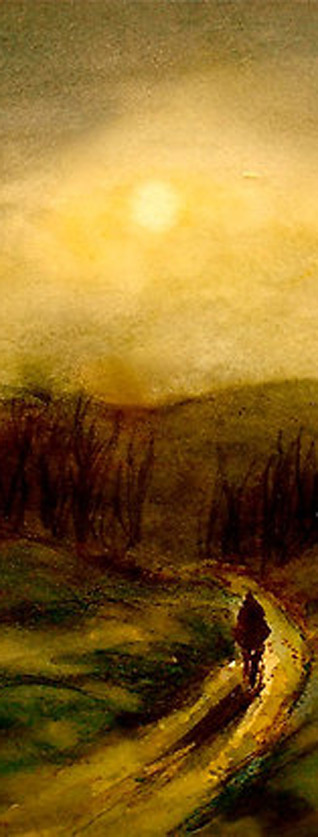Travel
Thomas Hardy's Egdon Heath
T. SHER SINGH
DAILY FIX
Monday, September 24, 2012
Though I had read Thomas Hardy throughout high school, I did not get his full impact until my University years.
The man who made Shakespeare’s Lear and T.S. Eliot’s Prufrock and Yeats’ Byzantium and Ionesco’ Rhinoceros come alive before our very eyes -- Prof. Devidas Chatterjee -- walked into class one day and, without a word of introduction, began to read a couple of pages from The Return of the Native.
He began:
“The heaven being spread with this pallid screen and the earth with the darkest vegetation, their meeting-line at the horizon was clearly marked. In such contrast the heath wore the appearance of an instalment of night which had taken up its place before its astronomical hour was come: darkness had to a great extent arrived hereon, while day stood distinct in the sky …”
The reader and the writer together painted an indelible picture of Egdon Heath -- the desolate wasteland that also reappears in Hardy’s other novels, almost like a protagonist - in my mind’s eye.
It wasn’t until some time later, however, that I discovered that the heath did exist in Dorset County in England, where Hardy had lived and written his epics.
It is at the “transitional point of its nightly roll into darkness,” wrote Hardy, “the great and particular glory of the Egdon waste began, and nobody could be said to understand the heath who had not been there at such a time.”
So, during a trip to England, I rented a car and headed south-westwards, past Southampton, in the direction of Plymouth, towards the southern coast. I was of course, headed for Dorset and Hardy’s Wessex.
Spent the morning in Salisbury, the afternoon at Stonehenge, and arrived at Hardy’s cottage a few miles outside Dorchester by the evening.
It’s exactly what I had expected.
Secluded and desolate, with no more than a few farm houses in the vicinity, it seemed to have hung on to the world that had once nurtured and created the writer who in turn recreated it in under the name of Wessex.
I parked my car some distance away and walked towards the village. My thoughts immediately went to Egdon Heath.
“The great inviolate place had an ancient permanence which the sea cannot claim. Who can say of a particular sea that it is old? Distilled by the sun, kneaded by the moon, it is renewed in a year, in a day, or in an hour. The sea changed, the fields changed, the rivers, the villages, and the people changed, yet Egdon remained.”
I wandered around until I came across a lone figure repairing a fence. He gave me a bit of the recent history … and then, directions to Hardy’s cottage.
Which way is the heath, I asked him. Egdon Heath?
He dusted his hands, wiped them on his apron, and said, “Let’s go. I’ll show ye around.”
We lingered at the cottage for a while, walked around the garden, jumped the fence at the back into a shaded laneway. We strolled through the trees. He talked, I listened, my mind unsure whether I was awake or dreaming. It couldn’t have been much different a hundred years ago when …
We left the woods behind and entered an area of scraggly vegetation. The trees disappeared. Suddenly, we were surrounded by a weedy growth, sometimes waist high, sometimes shorter, occasionally a brave sprout teetering at a precarious six feet or so. All around us, as far as I could see.
This, said my guide, waving his arm in a wide arc, is the heath.
It couldn’t be.
I swung around and stared at the spotty shrubs strewn in every direction, as far as I could see. It’s too green. It’s too - er - lush. “Not that it’s that green or lush!” I muttered under my breath. I can’t even see the horizon. It was difficult to explain.
“This is it, the Egdon Heath.”
It’s not the same, though, he added. It’s sad. The road to hell is paved with such good intentions. Some bureaucrats had decided a few years ago that Egdon Heath -- being so important to Hardy enthusiasts -- should be spruced up a bit. They poured in money, hundreds of thousands of it, to vegetate the area. To make it look ’nicer’. So that it wouldn’t look desolate anymore, they said. They failed over and over again. But they kept on trying. They just wouldn’t give up. So here you are, a dozen years later: Egdon Heath saved from desolation! No more a barren wasteland. This is the best they could do.
Petty bureaucrats everywhere, I moaned.
They cut down trees when they shouldn’t.
Here, they plant trees when they shouldn’t!
So Egdon Heath remains in my mind, sculpted and painted in Prof. Chatterjee’s thundering, reverberating voice, a place I still escape to when ‘civilization’ comes too close and begins to nip at me.
“A place perfectly accordant with man’s nature – neither ghastly, hateful, nor ugly; neither common-place, unmeaning, nor tame; but, like man, slighted and enduring; and withal singularly colossal and mysterious in its swarthy monotony!“



